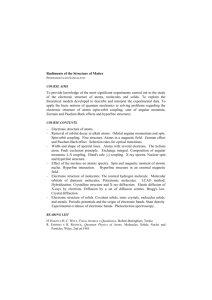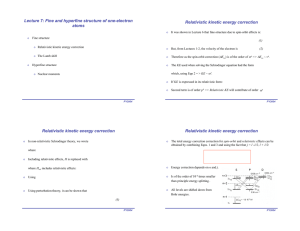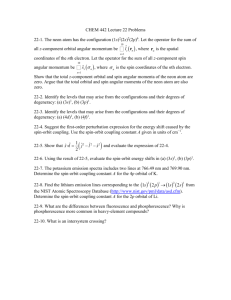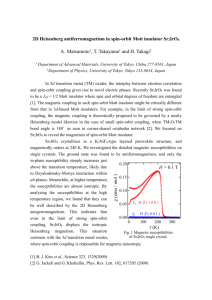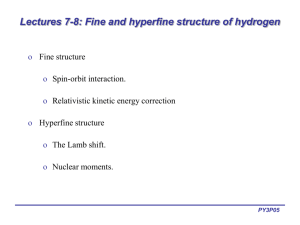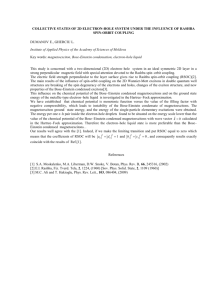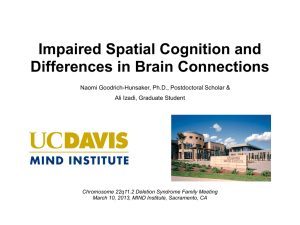Time-ind. Perturbation Theory II
advertisement
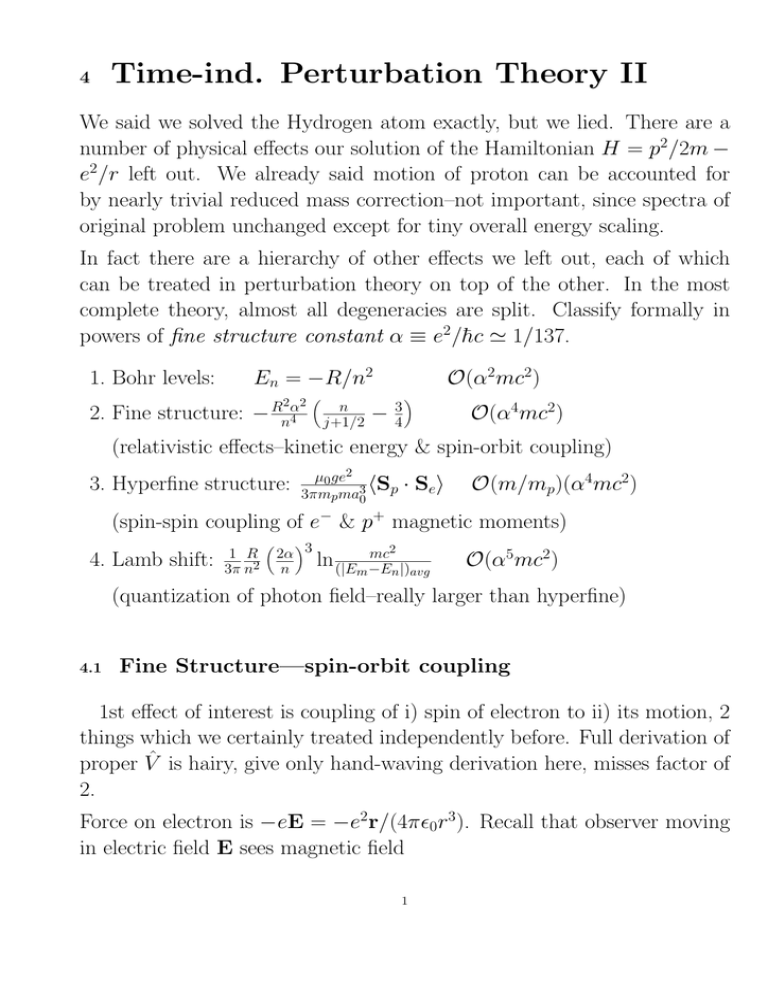
4 Time-ind. Perturbation Theory II We said we solved the Hydrogen atom exactly, but we lied. There are a number of physical effects our solution of the Hamiltonian H = p2/2m − e2/r left out. We already said motion of proton can be accounted for by nearly trivial reduced mass correction–not important, since spectra of original problem unchanged except for tiny overall energy scaling. In fact there are a hierarchy of other effects we left out, each of which can be treated in perturbation theory on top of the other. In the most complete theory, almost all degeneracies are split. Classify formally in powers of fine structure constant α ≡ e2/h̄c ' 1/137. 1. Bohr levels: En = −R/n2 2. Fine structure: 2 2 − Rnα4 µ n j+1/2 − O(α2mc2) 3 4 ¶ O(α4mc2) (relativistic effects–kinetic energy & spin-orbit coupling) 3. Hyperfine structure: µ0 ge2 hSp 3πmp ma30 · Se i O(m/mp)(α4mc2) (spin-spin coupling of e− & p+ magnetic moments) 4. Lamb shift: 1 R 3π n2 µ ¶ 2α 3 mc2 ln n (|Em −En |)avg O(α5mc2) (quantization of photon field–really larger than hyperfine) 4.1 Fine Structure—spin-orbit coupling 1st effect of interest is coupling of i) spin of electron to ii) its motion, 2 things which we certainly treated independently before. Full derivation of proper V̂ is hairy, give only hand-waving derivation here, misses factor of 2. Force on electron is −eE = −e2r/(4π²0r3). Recall that observer moving in electric field E sees magnetic field 1 v ×E c2 So electron with magnetic moment e ~µ = −g S, 2m should have energy B= v¿c (1) g'2 (2) V̂ = −µ · B e e v = −g S · r × 2m 4π²0r3 c2 (3) (4) so with L ' r × mv, get ge2 1 L·S V̂ = 2m2c2 4π²0r3 (5) Off by factor of 2 from full relativistic calculation (neglected Thomas precession!): 1 ge2 L·S V̂ = 4m2c2 4π²0r3 = f (r)L · S (6) (7) (8) Now define total angular momentum J=L+S (9) Jˆ2 = L̂2 + Ŝ 2 + 2L · S, (10) whose square is so V̂ = f (r) ˆ2 (J − L̂2 − Ŝ 2) 2 (11) Verify: Jˆ2, L̂2, Ŝ 2, and Jˆz now commute with H = H0 + V̂ . L̂z and Ŝz no longer do. We choose therefore to label states as 2 Thus we aren’t quite following prescription we set out, by looking at expectation value of V̂ in original eigenstates of H0. Why? Because we can find the new exact eigenstates with no work. So energy shift calculation is exact—except for higher order relativistic effects. In this basis we have (Jˆ2 − L̂2 − Ŝ 2)|n`sjmj i 3 = h̄2(j(j + 1) − `(` + 1) − )|n`sjmj i 4 (12) so energy shift due to spin-orbit coupling is δEso = hn`sjmj |V̂ |n`sjmj i 3 = h̄2(j(j + 1) − `(` + 1) − )hf (r)i 4 For hf (r)i we need 1 1 h 3i = r `(` + 1/2)(` + 1)n3a30 (` 6= 0) (13) (14) (see Griffiths Probs. 6.34, 6.35). Spin-orbit energy shift is therefore δEso En2 n(j(j + 1) − `(` + 1) − 43 ) = (15) mc2 `(` + 12 )(` + 1) En2 1 1 = 2n − (check for j = ` ± 1/2!) (16) 1 1 mc2 `+ 2 j+ 2 Note although (15) looks singular at ` → 0, proper relativistic treatment 3 by Dirac shows nonsingular result (16) is correct for all `–not obvious though! Relativistic kinetic energy corrections. Up to now we have neglected relativistic effects in kinetic energy term T̂ . Properly we should probably write r p̂2 p̂4 2 2 2 2 4 T̂ = p̂ c + m c − mc ' − + ... (17) 2m 8m3c2 Then we need to find the energy shift in |ψi to leading order in the per4 turbation V̂ = 8mp̂3c2 : 1 1 δErel = − 3 2 hψ|p̂4|ψi = − 3 2 hp̂2ψ|p̂2ψi (18) 8m c 8m c The rhs supposed to be evaluated using unperturbed wave fctns, so use (p̂2/2m − e2/(4π²0r))|ψi = En|ψi to find * * + 1 + 1 1 2 2 4 ] (19) [E + 2Ene +e δErel = − 2mc2 n 4π²0r (4π²0)2r2 The expectation values depend only on a0, n and ` as usual: * + * 1 1 1 1+ = = 2 ; r n a0 r2 (` + 1/2)n3a20 So full relativistic kinetic energy shift is En2 4n δErel = − − 3 2mc2 ` + 1/2 (20) (21) and full fine structure energy splitting is δEf ine = δEso + δErel (22) yielding an energy spectrum for hydrogen up to fine structure corrections of α2 n R E = En + δEf ine = − 2 1 + 2 − 3/4 (23) n n j + 1/2 4 Figure 1: Hydrogen fine structure—spin-orbit coupling 4.2 Hyperfine Interaction Hyperfine splitting of atomic spectral lines arises from interaction of electron & nuclear dipole moments. Whereas ground state in hydrogen not split by fine structure, it is split by hyperfine interaction, allowing for transition between two levels, producing radiation of wavelength 21 cm (∼ 10−7Ryd, allows tracking of hydrogen by astronomers, measurements of proper motion of celestial objects (Doppler shifts of line), & construction of stable atomic clocks. Calculation is lengthy, but can be solved by elementary methods to high accuracy (“real” quantum mechanics problem!). Magnetic field due to dipole moment µ: 1 3r(~µ · r) ~µ B= − 3 , 4π²0 r5 r (24) whereas the interaction of a magnetic moment with external field is U = −~µ · B 5 (25) Figure 2: If µ ~ p k ẑ, r k x̂, B k −ẑ, then µe k −µp in lowest energy configuration. If µ ~ p k ẑ, r k ẑ, B k ẑ, then µe k µp for lowest energy. Compare with (25). so interaction is 1 3(~µe · r)(~µp · r) (~µe · ~µp) − + V̂ = 4π²0 r5 r3 (26) where r = re − rp Magnetic moment operators: ~µe = −ge e Se ; 2Me ~µp = gp e Sp 2Mp (27) with gyromagnetic ratios ge ' 2.00, gp ' 5.59. Perturbation theory Want to use V̂ in (25) as perturbation, write H = H0 + Hf ine + V̂ , look for hyperfine energy shift δEhf in ground state |ψ0i.1 Can write ground state as |ψ0i = |ψ100(r)i|me mpi (28) −r/a0 q where 1st factor is spatial part, old friend ψ100 = e / πa30, 2nd factor represents spin state of electron and now proton, too (before we ignored proton spin since it didn’t contribute to energy, now we must include it as 1 Note we will focus exclusively on the ground state of the H-atom, where the spin-orbit coupling has already been accounted for. Although in general states of definite mp , me are not eigenstates because of the L · S coupling, for the S1/2 ground state, mj (e’value of Jˆz /h̄) is the same as ms (e’value of Ŝz /h̄) always since ` = 0. We call ms of electron me here, and ms for proton mp . 6 dynamical variable). Note there are four degenerate states before taking V̂ into account, since both me and mp can be ±1/2. A priori we expect that since V̂ commutes with Ŝ 2 = (Se + Sp)2, eigenstates of new H with hyperfine term should be eigenstates of Ŝ 2, i.e. either S = 1 (triplet) or S = 0 (singlet).2 21cm spectral line we’re looking for will be difference in √ shifts of 3 degenerate triplet√states [| ↑↑i, | ↓↓i, | ↑↓i + | ↓↑i)/ 2], and singlet state | ↑↓i − | ↓↑i)/ 2. So we want to evaluate3 δEhf = hψ00 |V̂ |ψ00 i à = 3(Se ·r)(Sp ·r) ge gp e2 hψ (r)|hSM | 100 16π²0 Me Mp r5 = − (Se ·Sp ) r3 (29) ! |SM i|ψ100(r)i ge gp e2 αβ 16π²0 Me Mp I hSM |Ŝeα Ŝpβ |SM i (30) where the |SM i are e’states of total spin Ŝ 2 and total Ŝz , and αβ Z 3rα rβ δ − 3 (31) I αβ ≡ d3r|ψ100(r)|2 5 r r is a tensor we have to evaluate using the wave function ψ100. Tedious but straightforward to show that I αβ = Iδαβ , with I = 8π|ψ100(0)|2/3 (see below!). I diagonal =⇒ only spin matrix elements we need are 1 hSM |Se · Sp|SM i = hSM | (Ŝ 2 − Ŝe2 − Ŝp2)|SM i 2 2 h̄ 1(1+1)− 12 (1+ 12 )− 21 (1+ 12 ) S = 1 = 0− 12 (1+ 21 )− 12 (1+ 12 ) S=0 2 h̄2 /4 S=1 = −3h̄2 /4 S = 0 (32) So energy shifts for singlet and triplet states are that Ŝ 2 commutes with V̂ by first writing Ŝ 2 = (Se + Sp )2 = Ŝe2 + Ŝp2 + 2 since [Ŝe , Ŝe,α ] = 0, similarly for Ŝp2 . Now Se · Sp obviously commutes with second [Se · Sp , (Se · r)(Sp · r)] = 0. To see this, use relation σi σj = δij + i²ijk σk . 3 Need to use states ψ 0 > in which V̂ is diagonal—these are precisely the |SM i! 0 2 Check 7 Se · Sp . First of all, Ŝe2 commutes with V̂ term of V̂ (see (25)), harder part is to see δEhf 2 h̄2 /4 S=1 8π|ψ100 (0)| 2 −3h̄ /4 S = 0 3 k 3 6 8M e e 6 3h̄ g e g p e2 = 16π²0MeMp 1 gegpe8Me2 S=1 = −3 S = 0 24π²0Mph̄4 (33) So splitting between triplet and singlet (energy of photon emitted in triplet decay) is h̄ω = δEhf (S = 1) − δEhf (S = 0) gegpe8Me2 = 6π²0Mph̄4 (34) and frequency of transition is gegpe8Me2 ν = ω/2π = 12π 2²0Mph̄5 = 1420405751.800 ± 0.028Hz (35) (36) or λ = c/ν = 21.1 cm. Value given is current measurement! Pf. of I αβ = 8π|ψ100(0)|2δαβ /3 Recall definition à Z I αβ ≡ 3 d r|ψ100 (r)| 2 3rα rβ δαβ − 3 r5 r ! Quantity I αβ is singular integral and must be handled carefully. Note 8 (37) 1. Off-diagonal terms vanish because in ` = 0 state answer must be invariant under rotation of coordinate system, so I αβ = Iδαβ . 2. Diagonal terms funky, since angular part of, e.g. I zz gives Z 2 2 dΩ (3z − r ) = 2πr 2 Z 1 −1 d cos θ(3 cos2 θ − 1) = 0 (38) but radial integral is proportional to Z dr e−r/a0 =∞ r (39) So we have to find way to take limit 0 · ∞ sensibly. Note singularity in (38) comes entirely from r = 0; if we were to exclude r = 0 from range of integration integral would vanish!. So consider very small sphere around r = 0, of radius r0 so small we can approximate smoothly varying fctn. ψ100 (r) by ψ100 (0). Consider diagonal elt. I zz (others must be same by rotation symmetry), express in cylindrical coords: I zz = |ψ100 (0)| = |ψ100 (0)| 2 0 2 = |ψ100 (0)|2 = |ψ100 (0)|2 = Z r0 Z r0 −r0 Z r0 à 1 3z 2 − dr r5 r3 √ Z 2 2 ! 3 dz r0 −z 0 " 2 dρ π " 3z 2 1 − (ρ2 + z 2 )5/2 (ρ2 + z 2 )3/2 2 −2z 2 + 2 dz π 2 2 3/2 (ρ + z ) (ρ + z 2 )1/2 −r0 Z r0 −r0 à dz 2π z2 1 − r0 r0 8π |ψ100 (0)|2 3 ! # #ρ2 =r2 −z 2 0 ρ2 =0 (40) 9
